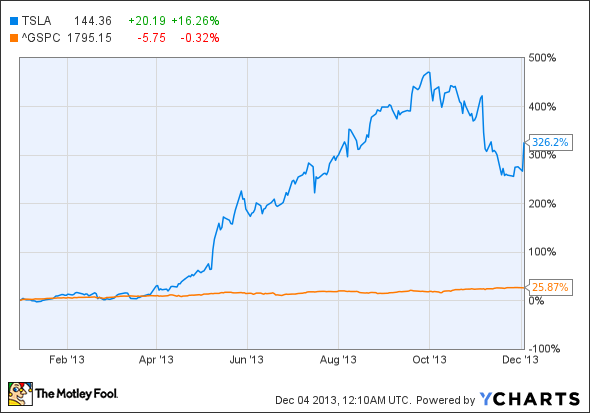
Although we don't believe in timing the market or panicking over daily movements, we do like to keep an eye on market changes -- just in case they're material to our investing thesis.
Stocks lost ground for the third day running, as the S&P 500 and the narrower, price-weighted Dow Jones Industrial Average (^DJI +0.16%) fell 0.3% and 0.6%, respectively.
One stock that bucked the general trend in no uncertain terms was Tesla Motors (TSLA 3.56%), which gained 17% after German authorities found "no manufacturer-related defects" to explain the fires that followed three recent crashes of its model S sports sedan. The model S is currently being investigated for a possible U.S. recall.
Tesla shares have been on an roller-coaster ride this year (see the following graph); even after today's pop, the stock is down roughly a quarter relative to the $194.50 all-time high it achieved at the end of September. However, that pullback is hardly surprising, following a blistering rally this year:
If you clicked on this article, did you notice the assumption contained in the title? "Is Tesla still a buy?" implies that it was a buy to begin with. Was that your assumption? It appears to be that of Morgan Stanley auto analyst Adam Jonas, who reiterated his "overweight" rating (English translation: "buy rating") on Tesla in a report published today:
We believe negative news flow on Model S fires, while clearly disruptive to the stock's momentum, will not cause material damage to the business. The pullback has created more than 20% upside to our $153 target. ... Tesla shares have moved from 20 percent overvalued to nearly 20 percent undervalued in just two months.
Jonas also selected Tesla as his top pick among the 26 auto stocks Morgan Stanley follows on the basis that it offers the best risk-adjusted (expected) return.
Here's why it's difficult to take Jonas seriously: Going by that excerpt from his report, it appears he believes he can peg Tesla's intrinsic value with a high degree of precision -- within 10%, say. No need for much of a margin of safety if you can do that, and, in that context, Tesla might well look more attractive than lower-growth, traditional automakers.
(Margin of safety is the discount a prudent investor applies to his estimate of intrinsic value to arrive at buy price that offers some protection against forecast error and/or deterioration in the company's fundamentals.)
How one can believe that is possible to derive Tesla's intrinsic value with any such precision is mystifying when one pauses to examine the myriad factors of uncertainty that could affect the company's growth and profitability outlook at this stage in the company's development. If you want evidence of that uncertainty, one need only consider the stock's volatility, which reflects investors' constant recalibration of future expectations.
As such, established automakers Ford (F +1.85%) and General Motors (GM +2.77%), both of which are valued at less than 10 times the next 12 months' earnings-per-share estimate (as opposed to Tesla's 129 multiple), look like much the better risk-adjusted values.

